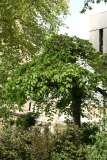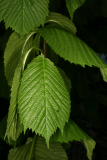Additional notes (click to expand)
Commemorative
Named for the Earl of Camperdown, Camperdown House, Dundee. See Nomenclature.
Medicinal
Ulmus glabra is first mentioned culturally in the Hypnerotomachia Poliphili of 1499 (Rhizopoulou, 2016). The botanist Matthioli (1544) commented on the medical benefits of elm bark and use of twigs to close wounds, remove scabies, make hair stronger, make skin beautiful and purge the intestines. Based on the teaching of the Greek botanist Theophrastus (3rd century BC), he recognised two species Campestris elm (“Ptelea,” U. minor) and Mountain elm (“Oroptelea,” U. glabra) and described them in detail.
British Ecological Society https://besjournals.onlinelibrary.wiley.com/doi/10.1111/1365-2745.12994
Nomenclature
This is a sport of Ulmus glabra or Ulmus x hollandica var vegeta. Named for the Earl of Camperdown, Camperdown House, Dundee, whose head gardener, David Taylor discovered it in circa 1840. It was transplanted it into the Earl's garden where it still lives. All other trees of Ulmus 'Camperdownii' are raised by grafting it onto Ulmus glabra rootstock as it does not come true to seed. It is susceptible to Dutch Elm disease, but rarely gets it 'because of its diminutive height'
Ulmus glabra Huds. 'Camperdownii'
Family: ULMACEAEGenus: Ulmus
Species: glabra Huds.
Cultivar: 'Camperdownii'
Common names: Camperdown Elm
Distribution summary: Northern Europe
Habit: Tree
Hardiness: H5 - Hardy; cold winter
Garden status: Currently grown
Garden location: Plants of the World (B)
Reason for growing: Medicinal

